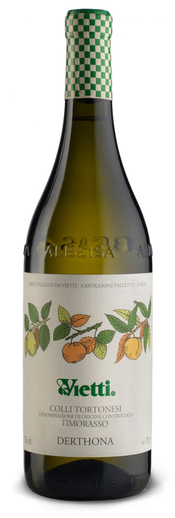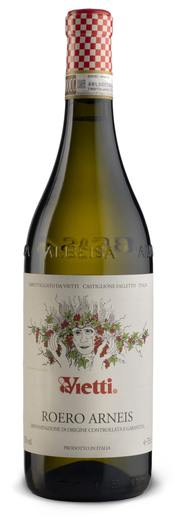Vietti, Colli Tortonesi DOC (Piedmont) Timorasso Derthona 2018 and Vietti, Roero DOCG (Piedmont) Arneis 2018 ($32 and $24, respectively; imported by Dalla Terra Winery Direct): Most of the wine lovers who know the name Vietti probably identify that winery as a red wine specialist. After all, Vietti produces numerous Barolo wines, Barbaresco, and Dolcetto, and is particularly recognized for its fine Barbera wines. But Vietti produces white wines also. For many years, the whites have included Moscato d’Asti “Cascinetta” — one of the best examples of this delicious wine — and Roero Arneis. Now the line-up has expanded to include Timorasso.
Both Arneis and Timorasso are native Piedmontese grape varieties that were rescued from obscurity, if not from extinction, in the last part of the 20th

century. Timorasso gained recognition through the efforts of Walter Massa, whose vineyards are located in the Colli Tortonesi area in southeast Piedmont; he began experimenting with wines from this grape in 1987 and made a splash with his 1997 single-vineyard release. Arneis began its modern life as a white wine in the hands of the late Alfredo Currado, former owner and winemaker of Vietti and the father of the current winemaker, Luca Currado; in 1967 Alfredo collected small lots of Arneis grapes from farmers in the Roero district, not far from the Barolo and Barbaresco zones, and earned acclaim for his 1968 Arneis from Italy’s leading wine critic at the time, Luigi Veronelli.
Vietti’s first release of Timorasso is the 2018. It hails from the Colli Tortonesi, as most Timorasso wines do, and it carries the designation “Derthona” which producers in that area use to indicate their zone. Vietti’s Arneis, in contrast, is now a staple in its portfolio, its vintages numbering in the dozens.
To taste the two wines side by side is fascinating. Timorasso is big and commanding, a wine that inclines you to let it linger in your mouth as you discover its character. Arneis is a flavorful, juicy charmer, easy to like and easy to enjoy without its being simple or ingratiating. Timorasso is what I would call an earthy white, while Arneis is undeniably fruity. Here’s more of what to expect when you taste each wine.
The 2018 Vietti Timorasso is dry and full-bodied with surprisingly high acidity for such a style. Its low-key aromas and flavors suggest pear, honey, fresh

thyme and mountain herbs along with a savory, tangy, mineral note especially in the mouth. The wine has rich texture and a bit of phenolic grip — a mild, tannin-like impression from the grape skins, not from oak. The long finish shows good concentration of fruit. The winemaking for the wine involves a long, slow fermentation (four weeks) in ceramic, wood and stainless steel containers and the wine does not undergo malolactic — hence its high acidity. The wine ages on its lees for ten months with stirring, in similar containers to the fermentation; the lees aging most likely contributes to the rich texture of the wine. My impression is that this Timorasso can develop favorably with several years of aging. “We made it for aging,” explains winemaker Luca Currado.
The 2018 Vietti Arneis has aromas of melon, lime, quince, almond and blossoms accompanied by grapefruit in its flavors. In the mouth there’s a slight energetic spritz of carbon dioxide that recedes to become subliminal as the wine opens up. The wine is dry-but-fruity, not at all austere, with fairly high acidity and a rich, oily-like texture. This wine speaks of freshness, fruitiness, and flavor; it’s the kind of wine that anyone can enjoy. The winemaking technique was geared to preserving freshness and flavor — the juice was clarified after pressing to remove solids, the juice was vinified in pressurized stainless steel tanks to preserve some natural carbon dioxide, malolactic conversion was avoided to maintain vivid flavor, and the wine aged only briefly in stainless steel before bottling.
“In terms of winemaking, Arneis and Timorasso are the opposite, Luca Currado remarked. “For Arneis, you want to use a reductive fermentation, [avoiding oxygen and] retaining some CO2…but Timorasso needs AIR!” he said emphatically. Exposure to oxygen is necessary to prevent the wine’s flavors from becoming inexpressive.
Two white wines from resurrected native Piedmont grape varieties, two white wines from the same producer, and yet two very different white wines.
Timorasso, 92 Points
Arneis, 90 Points